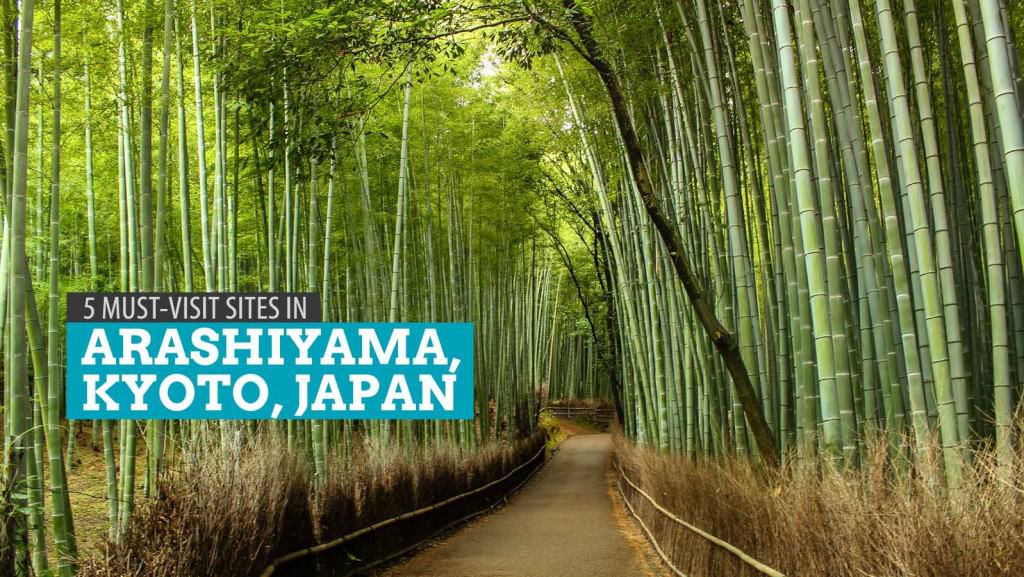There were four pictures hanging on a wall just outside Tenryuji Temple. Each frame showcased the visual character of the site per season — clad in the fiery colors of autumn, dressed in white snow in winter, adorned with the pink glow of cherry blossoms in spring, and, finally, drowned in a sea of verdancy in summer. Three of the four scenarios would have been such a first-time treat. I had never seen autumn leaves or snow or cherry blossoms. Unfortunately for me, it was midsummer.
The deciduous forest of the Arashiyama district was very lush and green — awfully green — during my visit. Green is great; I love green. But as a guy who hailed from a tropical island carpeted in evergreen rainforests, it was not really the color I was excited to bombard my eyes. The farther I walked into the place, the more I realized that it was a mistake booking June tickets to Japan. What was I thinking? Was I even thinking when I booked it? But kicking myself in the butt lasted for only a minute. Summer may not be the best time to be here, but the proverbial silver lining appeared amidst the greenery. There were fewer tourists, and the weather was pleasant, perfect for a long afternoon walk. That or I was just mastering the art of sweet lemoning. Tee-hee.
Togetsukyo Bridge
Straddling the Ōi River, the Togetsukyo Bridge is one of the most iconic pictures of Kyoto. In spring when cherry blossoms decorate the banks of the river, the bridge makes for a postcard-perfect subject. Built in 836 to provide better access to the nearby Horinji Temple, it has become an iconic structure, representing the Japanese’s clinginess to the past and simple way of life. Its name, which means “Moon Crossing,” was bestowed upon it by Emperor Kameyama. Since then, it has seen feudal wars, hosted samurai battles, and inspired some of the best haiku poems.
Horinji Temple
Sitting atop a hill overlooking Togetsukyo Bridge is Horinji Temple. It is one of the five head Shingon Buddhist temples in the city of Kyoto. According to legend, Emperor Genmei ordered the monk Gyoki to build it in the year 713. It was known as Kadonoidera Temple at the time. In 829, it became the new home of an image of Boddhisatva Akasagarbha (Kokūzō Bosatsu) and was since called Horinji Temple.
Save for the caretaker, there was nobody else at the temple despite the crowds flocking around the other temples in the area. Such a shame because its high elevation allows fantastic views of the district and even Kyoto.
Part of the reason it is not as frequented could be that it is concealed behind the trees at the far end of the bridge. Even I had a difficult time finding it. I was on the verge of giving up when a lovely vendor pointed us to the right direction. The temple is accessible via a narrow staircase that starts beside a traditional pastry store at the end of the Togetsukyo.
Tenryuji Temple
Regarded as the best among the Five Great Zen Temples of Kyoto, Tenryuji Temple has been declared by the Japanese government as a Special Place of Scenic Beauty and in 1994 was inscribed as a UNESCO World Heritage Site. It was originally founded in 1339 by Shogun Ashikaga Takauji as a place to console the spirit of Emperor Go-Daigo. Zen master Muso Soseki was the founding priest. Today, it is a major tourist destination, alluring everyone with its Zen beauty and tradition.
An exquisite garden encloses this temple, which makes the walk getting here an event in itself. Once again, I imagined how it looked during spring or fall as I strolled around it. Next to an abbey hall is the Sogen Pond, which is frequented by many species of birds. A large heron made an appearance at the pond while I sat by the hall.
Nonomiya Shrine
Nonomiya Shrine means “Shrine in the Country.” A Shinto shrine, it was founded around 800 AD, but its location has changed through the years. It houses many images of gods, but the most notable are the god of marriage and the god of easy delivery. There used to be several nonomiya shrines, believed to be the temporary home of saios. In ancient Japan, a saio was an Imperial princess who was chosen to serve a god. This particular nonomiya sheltered a daughter of Emperor Saga in the late 8th century.
Bamboo Forest
Right after the garden exit is the start of the breathtaking groves of green bamboos. (Green again! But no one’s complaining now!) These imposing grass stalks towered above a narrow walking trail that meanders through it.
I had never seen any other place in Kyoto more picturesque and therapeutic than this! Bikers breezed through and lovers ambled sweetly under its thin canopy, enjoying a chlorophyll-colored dream. These bamboo trunks whispered gaieties that blew what was left of the summertime sadness that I carried in my heavy heart.
Arashiyama smothered me with a verdant pillow and I was ironically enjoying the way it took my breath away. Indeed, being here during summer had a silver lining, except it wasn’t silver at all. It was very, very green.
How to get to Arashiyama: From Kyoto Station, take the JR Sagano Line (aka JR Sanin Line) to Saga-Arashiyama Station. Travel time: 15 minutes. Fare: JPY 230. From the Sagaarashiyama Station, the central Arashiyama area can be reached on foot in 5 minutes.
